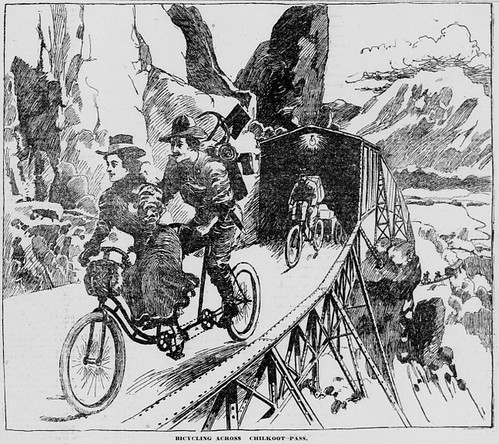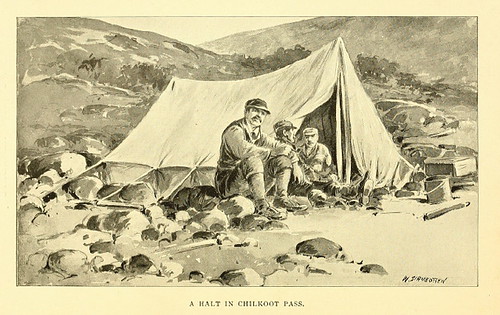
A depiction of a proposed "bicycle track" to ease access to Yukon gold
The article's text is sufficiently amusing to reproduce fully, below. Note that the developer expects both wheelmen and wheelwomen to use the track, as shown in the illustration.
"Charles H. Brinkerhoff Jr. Will Build a Bicycle Track to the Yukon."Perhaps telling is that the "dateline" for this article, published in Minnesota, was Newark, New Jersey, where Mr. Brinkerhoff was attempting to "secure the necessary capital to carry out the scheme" (as the article puts it) - and not a bit closer to the action, in Alaska.
Since the yellow serpent of the Klondike reared his head and fascinated the people of two hemispheres by the golden glitter of its eyes, there have been many plans devised for getting safely past the barrier of frozen mountains that guard the coveted prize. Some have had the earmarks of lunacy, and some have been of the variety that impels people to say, "Why didn't we think of that before?" A plan that has provoked more criticism and caused more comment than any was born in the brain of Charles H. Brinkerhoff Jr., of this city, after severe travail of soul and many sleepless nights. Mr. Brinkerhoff proposes to build a bicycle track to the Klondike, provided he can secure the necessary capital to carry out the scheme.
"There is nothing visionary about the plan," said Mr. Brinkerhoff, when asked to give publicity to his ideas on the subject of a Klondike bicycle track. "On the contrary, it is the only correct solution of the problem of how to bring the gold of the Yukon within the reach of all. It isn't every one who can afford to pay the price of a passage to the Klondike by the expensive routes at present in use, but nearly everyone owns a bicycle nowadays, and when my track is completed the trip to the gold district will be brought down to two or three weeks from the nearest American city.
"To go into details, I may say that the plan provides for a roadway, lightly constructed of steel, clamped to the sides of the mountains where it is not possible to arrange for a roadbed on a flat surface, and put together in the strongest manner known to modern builders. The roadway will be fashioned according to mathematical principles, so as to make tha journey as easy for the bicyclists as is compatible with such a rough mountain trip. When it is possible, steep up-grades will be avoided, and tbe entire road so arranged that the mountain climbing will be done almost without the bicyclist being aware of any uphill work. When the nature of the ground renders it impossible to avoid a steep ascent, I shall compensate the climber for his toil by providing a down-grade run, so that he can recover his strength by coasting. The structure will be absolutely safe, for it will rest on steel supports cemented into the solid rock and capable of bearing a strain of ten times as great as that it will be subject to as a bicycle track. The erection of the track will be an easy matter, for I hope to have the route carefully surveyed, and the girders, supports, etc., made to fit, so that the only thing necessary when the work ls ready to begin will be for the workmen to fit the sections together, bolt the girders and supports firmly and attach them securely to the rocky foundation.
"So much for the general construction of the roadway. Now as to the various novel features that I hope to introduce to render safe the trip to the Klondike by way of my bicycle track, and to brighten the burden of the journey so that it will be as enjoyable as a pleasure trip. I assume that my bicycle track will be utilized by women, for where the wheel takes men nowadays it usually takes women also. Even athletic women are grateful for the comforts of life, and, so far as a trip to the Klondike can be made comfortable, my bicycle track will insure it. Every twenty-five miles of the journey there will be a station, lighted and heated by electricity and provided with seats and tables and a restaurant so that pilgrims to the gold district can rest and refresh themselves. I propose to place the stations as near together as twenty-five miles because I realize that in the inhospitable Klondike region storms are of occasional occurrence, and I wish to have a place of refuge whither the wheelmen, and especially the wheelwomen, can flee for safety when the elements behave badly. I want to take every precaution to guard against a tragedy. There has been enough of that already in the senseless rush for the Yukon.
"I take it that fifty miles a day on a smooth roadway, such as that I propose to construct, will be fairly good going. At the end of a fifty-mile run, cumbered with baggage, pick and shovel, the bicyclists will welcome a place where they can camp for the night. To provide this, I shall arrange to have houses erected at fifty-mile intervals along the route. The houses will be built of the same material as the roadway, and will contain every requisite for making the travelers comfortable.
They will be in reality cozy hotels where food and shelter can be obtained at moderate prices, and the wheelmen will be sure of a welcome and a warm room after their fifty-mile ride. If fifty miles a day is too much for some of the women, they can find a comfortable halting place in the twenty-five-mile stations, where an attendant will minister to their wants, and good meals will be served at low rates.
"This is, of course, the plan in embryo. I have to work out many difficult problems, but capitalists to whom I have submitted the idea are so much impressed with its feasibility that this much is certain — the road will be built. When finished, it will be the greatest bicycle roadway in the world, and I claim that it will not only bring the Yukon within the reach of all who own a wheel, but will be the means of lowering the death rate in Alaska by providing a route to the gold district that will be safe from the terrible hardships under which so many have succumbed in the past."
Mr. Brinkerhoff is a young man of considerable mechanical genius, brimful of energy and plugk, and there is no doubt that he has the greatest confidence in his plan for reaching Alaska by wheel. Practical engineers to whom the idea has been submitted declare that it is by no means an idle dream, but has all the elements of a thoroughly feasible proposition.

From a book of advice on going to the Klondike
A chapter towards the end of "Klondike : the Chicago record's book for gold seekers." published in 1897 offers some insights into some of the more outlandish schemes to support nascent gold miners, including a suggestion to use a large hot air balloon and another bicycle proposal:
The bicycle man is not going to permit the balloon man to get ahead of him on any proposition. So that old stand-by, "a syndicate of wealthy New Yorkers," proposes to establish trading posts and stations along the route from somewhere to the Klondike. This route is to be a bicycle path, and the bicycle, of course, is one of the specially designed kind, made only for this particular purpose. A picture of the bicycle indicates that it has a kind of an out-rigger attachment at the end of which is another bicycle wheel, but whether that wheel is intended to hold up the bicycle on a mountain side or to get over an air-hole on an ice-patch is not disclosed.As it turns out, the most significant technological development at the Chilkoot Pass did not involve bicycles, but rather the use of aerial tramways to haul the large amount of freight required by the Canadians to allow entry from the United States to the gold fields. The use of these aerial trams for freight was superseded by a narrow gauge railway across the longer, but less difficult, White Pass route, shown in this short movie clip by Edison's production company from 1901.
The bicycle syndicate also announces that it will "purchase all promising' claims on the market," and will have nothing whatever to do with the "common methods of transportation, such as railroads, boats, pack horses, dogsleds and Indians."
How often do you see the male as stoker in a coed tandem team? Seems interesting. Are they implying some progressiveness here?
ReplyDeleteAlas, I don't think so. There were tandems produced for men and women at that time that had the step through either in the front (as shown here) or in the back, depending on various theories as to which was more appropriate. Having the woman in front was more "gallant" was the thinking and the man was assumed to be able to see over the woman - and these bikes had rods to connect the rear handlebars to the front wheel - you can see that in this 1899 photo,here -
ReplyDeleteHttp://flic.kr/p/AeicRA. In practice we can't know if men did most of the steering with such bikes but it gave the appearance that that they could.